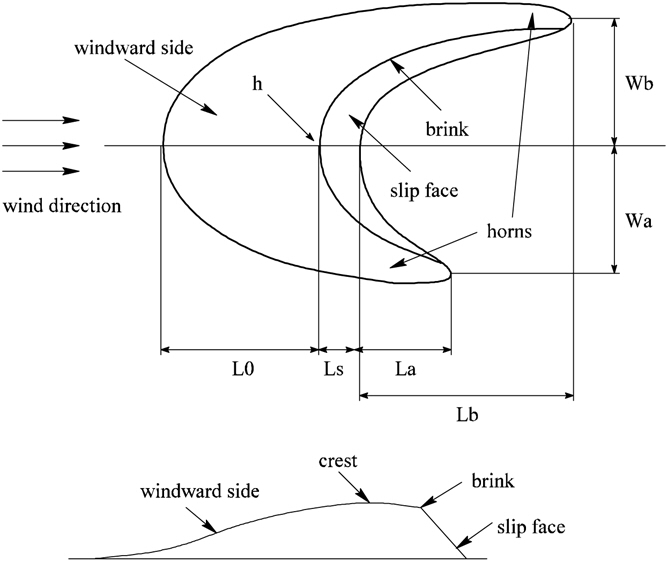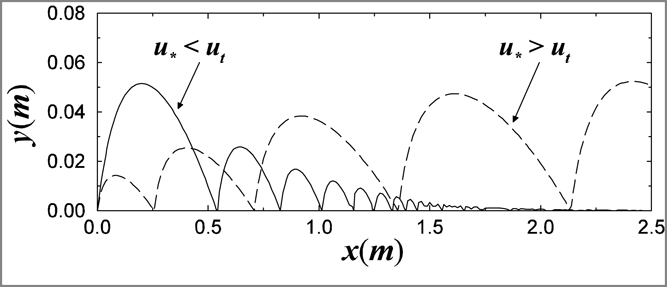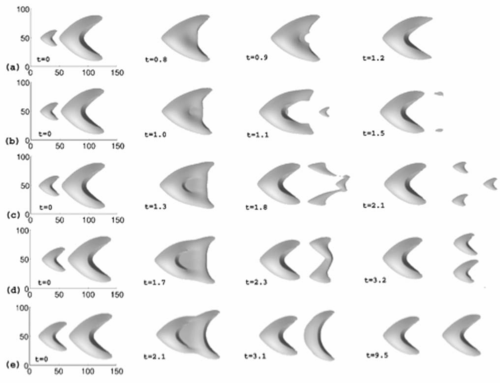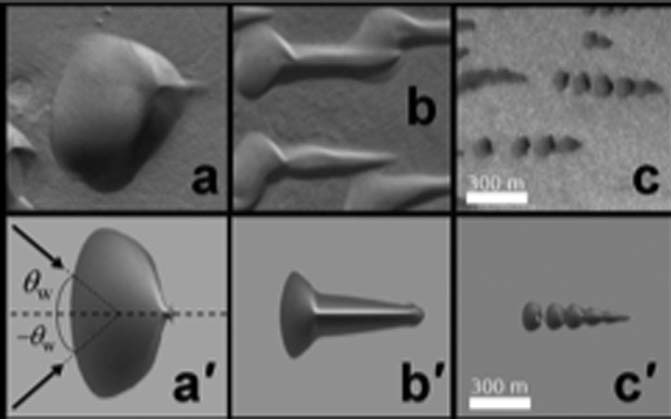 |
SIAM News
Dune Dynamics at DS ’07
Volume 40, Number 9, November 2007
By Barry A. Cipra
The answer, my friend, is blowin’ in the wind.—Bob
Dylan
Sand dunes are ubiquitous, sometimes problematic features of deserts and
coastlines. Their undulations call to mind ripples on water, but dunes
and water waves differ in crucial ways. In particular, whereas “traveling” water
waves are largely illusory, a product of motion that is
essentially up and down, the advance of sand dunes really does involve material
transport: Individual grains of sand are blown by the wind along nearly horizontal
trajectories, as anyone whose face has been sandblasted at the beach on a
breezy day will know. Errant dunes have been known to block roads and overrun
buildings.

Figure 1. Anatomy of a dune. Forces exerted by wind, gravity, and
friction determine the
shape of a barchan. Figure courtesy of Hans Herrmann.
Because of how they move, sand dunes also differ from water waves in shape.
Of particular interest is a class of crescent-shaped dunes known as “barchans” (see
Figure 1, top). In an invited address at this year’s SIAM Conference
on Applications of Dynamical Systems, held in Snowbird, May 28 to June 1,
Hans Herrmann of ETH Zürich described analyses he and colleagues have
done of these fascinating formations.
The seminal scientific study of sand
dunes, The Physics of Blown Sand and Desert Dunes, by Ralph Bagnold, dates
back to 1941. In his book, Bagnold provided a Goldilocks-like classification
for the aeolian (wind-driven) transport of sand. Sand that’s too coarse
creeps along the ground; sand that’s too fine stays in suspension,
blowing great distances. In the “just-right”
phase, corresponding to grain diameters between 0.1 and 0.3 millimeters,
sand moves by a process called “saltation,” from the Latin verb
saltare, meaning “to leap.”
In saltation, the impact of a given sand grain transfers momentum to other
grains, which follow ballistic trajectories accelerated by the wind until
they too hit the surface, kicking up other grains in turn. Because some kinetic
energy is lost in the (inelastic) collisions, saltation dies out if the wind
speed is too low, but it grows exponentially if the wind speed exceeds a
certain threshold (see Figure 2). The latter case is selflimiting: Blown
sand sucks energy out of the wind, eventually reducing its speed.
Saltation, Bagnold found, is the dominant mechanism in the formation of
all sand dunes. The dunes will be barchans when wind blows mainly from one
direction over largely flat terrain with relatively little sand. (When sand
is abundant, formations known as transverse dunes are the rule.) Sand builds
up on the backside of an incipient bump and slips around the sides to form
a pair of arms reaching downwind. The build-up near the crest eventually
reaches an unstable slope on the downwind side known as the angle of repose,
which for sand is roughly 34 degrees. Sandslides leave the dune with an axial
profile consisting of a shallow curve on the upwind side and a steep straight
line downwind
(see Figure 1, bottom).

Figure 2. Saltation dies out if wind speed is too low (solid
curve), but becomes self-sustaining
for winds in excess of a critical threshold (dashed curve). Figure
courtesy of Hans Herrmann.
Barchans typically appear in clusters, often made up of thousands of separate
dunes of various sizes. Much like glaciers, barchans appear to be stationary
but in fact advance slowly, on the order of centimeters per day. (Unlike
glaciers, though, the physical transport of sand grains takes place only
in a surface layer; a given grain travels in fits and starts, going great
distances in a matter of days before being stochastically buried for years,
decades, or centuries.) Small dunes, it’s been observed, travel faster
than large ones. This begs the question, What happens when a small barchan
overtakes a larger one?
People have not been measuring sand dune migration long enough to have observed
the dynamics of interacting dunes—no ancient astronomers of sand kept
meticulous records of barchan vagaries. Modern researchers have proposed
various explanations, ranging from simple, permanent coalescence to soliton-like
behavior in which the small dune merges momentarily with its bigger brother,
only to reemerge in its original size and shape on the other side.
Herrmann and colleagues, including current and former students Gerd Sauermann,
Veit Schwämmle, and Orencio Durán, have spent much of the current
decade bringing computational precision to the study of dunes. They have
extended the earlier analytic models of sand physics, developed computer
models to solve the equations of shape and motion, and done field experiments
with dunes in Morocco and Brazil, among other locations. Their in
silico barchans look a lot like the in silica originals.
An obvious starting point for analyzing sand flow is conservation of
mass: The piling up or erosion of a dune at any point—i.e., the time
derivative of dune height—is proportional to the gradient of the flux.
The latter is a function of wind speed (itself a function of height) and
the
dynamics of saltation, which includes coefficients of drag and restitution.
Because all motion occurs at the surface, the units of flux are kilograms
per meter per second, rather than kilograms per meter squared per second;
the constant of proportionality is the density of sand in the
mobile surface layer.
Bagnold derived a simple formula for the flux, finding it to be proportional
to the cube of the wind friction speed u, for speeds in excess of
the threshold speed ut, which is about a third of a meter per second. (Wind
friction speed is derived from the vertical profile of wind speed,
which depends on surface roughness.) In the 1970s, Heinz and Katharina Lettau
of the University of Wisconsin modified Bagnold’s formula to
make flux proportional to u2(u – ut). Herrmann’s group has derived
a yet more complicated formula based on a closer look at the details of saltation.
Their formula still has flux asymptotic to u3 for large u, but takes a different
form for speeds just above the threshold and gives results that,
after parameter fitting, agree well with wind tunnel experiments.
Using their equations and the commercial code FLUENT, Herrmann and colleagues
have simulated barchan formation and motion. The computations
generate the graceful crescent shapes of observed dunes and reproduce their
relative migratory speeds. In a 2003 paper in Nature, Herrmann
and Veit Schwämmle described soliton-like behavior when a smaller barchan
catches up with a larger one. In further work, Herrmann and
Durán found a range of behavior, depending on the ratio of dune volumes
(dividing the smaller by the larger). Solitonic pass-through occurs
when the ratio is larger than about 0.25. For ratios under 0.07, the smaller
barchan is simply swallowed as it climbs the backside of the larger
one. Between 0.07 and 0.14, the smaller dune emerges as multiple barchanettes,
a process the researchers call “breeding.” From 0.14 to 0.25,
the smaller dune splits in two, as if “budding” off the horns
of the larger barchan (see Figure 3).

Figure 3. Simulations show various possible outcomes
when a smaller barchan overtakes a
larger one, depending on their relative sizes: coalescence (a), “breeding” (b
and c), “budding”
(d), and solitary wave behavior (e). The height of the larger barchan is 5 meters;
the heights of
the smaller barchans are 1.8, 1.9, 2.2, 2.6, and 3.1 meters, respectively. Time
is given in
months. From “Breeding and Solitary Wave Behavior of Dunes,” by Oscar
Durán, Veit
Schwämmle, and Hans Herrmann.
The speed at which a barchan moves, Bagnold found, is inversely proportional
to its height. That would seem to imply a nonsensically nearinfinite
speed for nano-barchans. In fact, barchans below a certain critical size
are simply not seen. Herrmann, Durán, and Eric Parteli have
shown that the barchan-forming threshold depends on the wind speed and the
flux of sand in the area between dunes: As the values of these
variables increase, the threshold drops. (Intuitively, this makes sense:
A dune cannot move faster than the wind that carries the sand.)
Herrmann and Durán also recently derived a set of differential equations
describing the competition between dune mobility and plant growth.
Vegetation tends to retard erosion (mainly by slowing down the wind) and
to persist until deposition buries (and kills) it. Plants take root most
easily where the erosion/deposition rate is small to begin with. For barchans,
this includes the horns of the crescent. As a consequence, the horns
are pinned by plants while the crest between them advances, until the barchan
inverts into an upwind-pointing parabola. Herrmann and Durán’s
equations offer insight into the salta-tion/vegetation battle. According
to simulations based on their model, for example, inversion occurs only
when the (dimensionless) ratio of characteristic erosion rate to vegetation
growth velocity is smaller than about 0.5.
In another recent paper, Herrmann, Schwämmle, Durán, and Pedro
Lind considered the dune size and spatial distributions in barchan fields.
Their key equation, derived by a mean-field approach, relates the characteristic
interdune spacing L to the average dune width W and the standard deviation
S of the distribution of widths: L is proportional to S3/W2.
In other words, the sparser the dune field, the greater the variability
in dune size. (The size distribution itself is found
to be log normal.)
Not unique to Earth, sand dunes are also
abundant on Mars. Many of the crucial constants—
gravity, wind resistance, and grain
size—are different, but the physics is otherwise
the same. In a detailed analysis, Herrmann and
Parteli showed that saltation is an order of magnitude
more sensitive to wind speed increments
on Mars than on Earth. The strength of Martian
gravity being about 38% of that on Earth, a
kicked-up grain is accelerated by the wind
roughly seven times longer than an equivalent
grain on Earth. When feedback effects are
included, Martian sand grains attain ten times
the speed of their terrestrial counterparts. The
researchers have found that certain observed
dune fields are consistent with wind friction
speeds of about 3 meters per second. Other
fields, they’ve found, can be explained (in their
model) only under the assumption of a bimodal wind regime, with the wind
alternating between two directions (see Figure 4).

Figure 4. Alternating explanations. Unusual dunes
on Mars (top) can be reproduced in simulations
by assuming an alternating wind field (bottom). From "Saltation Transport
on Mars," by
Eric Parteli and Hans Herrmann. (Martian photos taken by the Mars Orbiter
Camera, courtesy
of NASA/JPL/MSSS.)
The study of dunes, Herrmann points out, involves all three components of
modern science: theory, computation, and experiment. Field measurements,
he says, are vital. Given where dunes tend to be found, experiments are also
hot, dirty, grueling work. Herrmann recalls an urgent call
from Parteli’s mother, shortly after Parteli returned from a two-week
trek through South America, begging Herrmann not to send her son on the
next field trip. Parteli, it seems, had mentioned that for his next assignment
he would be studying the dunes on Mars.
Barry A. Cipra is a mathematician and writer based in
Northfield, Minnesota.
|






